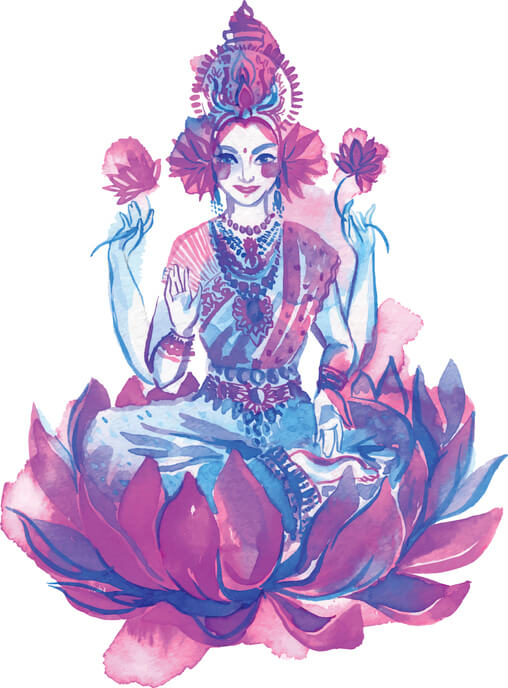You may have heard the word, puja, before and you may have heard it in association with temples in India or a yogi’s personal altar.
Puja means “to make an offering to the Divine with a show of respect.”
This usually takes the form of a special ceremony at a Hindu temple, or it can take place in the comfort of your own home.
All you need is a dedicated space, a decorated altar and some offerings. Here's everything you need to know to get you started!
Make an Altar
To create your own daily puja, or devotional time, you'll first need to make a personal altar. Creating an altar is a great way to really discipline your daily sadhana, or personal practice.
The altar gives you a concrete and visual place to go and be with Spirit. Having an altar can support your daily meditation practice. It can give you a place to pray, set intentions for your life, and connect to the Divine — within you and without.
Read: Savor Your Sadhana: A Guide to Creating Your Daily Spiritual Practice
How do you make an altar?
First you need a little corner or space in your house; it could be in your bedroom, study or living area. You just need a designated space that holds the space for your puja.
Next you need a small table. If you have an old dresser or cabinet that has doors and opens up, all the better. An old entertainment center that has doors on either side and opens up is great, too.
Shop your local thrift stores if need be. Recycling old furniture is an draftl way to make an altar.
Decorate
Finally, you'll need a beautiful silk in a color that resonates with your soul at the moment. Cover your table with this lovely silk material in a fashion that is a feast for your eyes.
Remember, you’re going to be looking at this altar every morning, and perhaps even every evening, so you want to be attracted to it.
Whether you have a cabinet you’re using or a table covered in that gorgeous piece of silk, now it’s time to decorate. This is your time to be creative.
Do you have a favorite flower? Orchids last for months and complement an altar rather beautifully.
Many people like to string their altars with garlands, bells or even little white lights. You can get festive here, treating it like a ceremony of Spirit.
If you have a set or two of mala beads, lay them on your altar. If you have a meditation cushion, leave it resting in front of your altar.
Read: Meditating With Mala Beads
Choose a God, Goddess and/or Guru
Take a moment to get still and quiet. Ask yourself, “Which Hindu gods or goddesses do I want to pray to? Which ones do I want to invoke on a regular basis?"
Is it Saraswati, for all her creative inspiration? Is it Lakshmi, for her beauty, abundance and auspiciousness? Perhaps it’s Lord Shiva or the sweet Vishnu. Maybe you have more than one Hindu deity who resonates with you.
Or perhaps there’s a deity from another tradition that feels closer somehow. Take some time to choose images of the Divine that are right for you and your spiritual growth.
You can purchase little postcards and images of your chosen Hindu deity or deities online or in Indian grocery stores. If you have a guru or saint you’re devoted to, you’ll want to put a framed picture of him or her on or above your altar.
If you choose a god or goddess to center your altar around, you may want to do some research. Different colors are linked to different gods and goddesses, as are certain mantras, days of the week, months, planets, scents and flowers.
For example, the goddess, Lakshmi, loves the colors red, pink, purple, green, white and gold. She is associated with the heart chakra and her day of the week is Friday.
Her mantra is Shreem and her planet is Venus. Her animals are the elephant and the owl. Her scents are sandalwood, rose, lotus and jasmine, and her flowers are roses and lotuses. Your puja to Lakshmi might include these colors, scents, flowers and animal icons.

Read: Abundance-Boosting Mantra & Meditation of Goddess Lakshmi
Bring Offerings
Offerings are another aspect of a puja, and each god and goddess prefers different fruits, vegetables, sweets, spices and even money or coins.
Lakshmi is said to be a vegetarian and prefers ripe fruits and veggies, sweets, lotus seeds, saffron, turmeric and sandalwood paste. She also likes ghee, milk and honey.
If you have the time to do a nice ceremony once a week, you would pick a Friday, early evening, and offer her some of the things she loves, while also doing japa with her mantra.
Read: The Makings of a Japa Mantra and How to Add This Yogic Practice to Your Sadhana
This Is Your Sacred Space
As you can see, the creation of a puja altar can be a lot of fun and also complex. Take your time and put some conscientious effort into it, for this is your sacred space for ceremony and one that you’ll want to spend time in each day.
Let your heart guide you as you create your very own puja.
During These Times of Stress and Uncertainty Your Doshas May Be Unbalanced.
To help you bring attention to your doshas and to identify what your predominant dosha is, we created the following quiz.
Try not to stress over every question, but simply answer based off your intuition. After all, you know yourself better than anyone else.